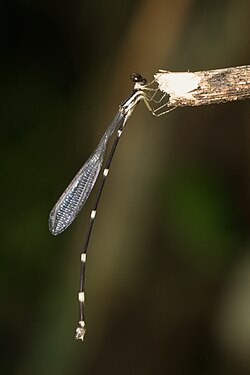Protosticta gravelyi
| Protosticta gravelyi | |
|---|---|

| |
| male | |

| |
| female | |
| Scientific classification | |
| Kingdom: | |
| Phylum: | |
| Class: | |
| Order: | |
| Family: | |
| Genus: | |
| Species: | P. gravelyi
|
| Binomial name | |
| Protosticta gravelyi Laidlaw, 1915
| |
| Synonyms | |
| |
Protosticta gravelyi,[2][3] pied reedtail[4][3] is a damselfly species in the family Platystictidae. It is endemic to Western Ghats in India. It is very widely distributed in hill streams of Western Ghats from Goa to Agasthyamala hills in Thirunelveli district of South India.[1][5]
Description and habitat[edit]
It is a large slender damselfly with bottle-green eyes. Its thorax is glossy black, marked with a broad, creamy-white stripe on each side. There is a similar stripe on the posterior part of metepimeron. Abdomen is black, marked with white and blue. Segments 1 and 2 are white laterally. Segment 3 is with a narrow basal annule. Segments 4 to 7 are with broad basal annules. Segment 8 is with its basal half turquoise-blue and segments 9 and 10 are unmarked. Anal appendages are black. Female is very similar to the male, but shorter and more robustly built.[6]
It is usually found in first and second order streams with good riparian forest cover. Adults fly very low and rest in riparian vegetation.[6][7][8][4][3]
See also[edit]
References[edit]
- ↑ 1.0 1.1 Subramanian, K.A. (2011). "Protosticta gravelyi". IUCN Red List of Threatened Species. 2011: e.T175162A7115762. doi:10.2305/IUCN.UK.2011-1.RLTS.T175162A7115762.en. Retrieved 19 November 2021.
- ↑ Template:World Odonata List
- ↑ 3.0 3.1 3.2 "Protosticta gravelyi Laidlaw, 1915". Odonata of India, v. 1.00. Indian Foundation for Butterflies. Retrieved 2017-03-13.
- ↑ 4.0 4.1 "Protosticta gravelyi Laidlaw, 1915". India Biodiversity Portal. Retrieved 2017-03-13.
- ↑ K.A., Subramanian; K.G., Emiliyamma; R., Babu; C., Radhakrishnan; S.S., Talmale (2018). Atlas of Odonata (Insecta) of the Western Ghats, India. Zoological Survey of India. pp. 55–56. ISBN 9788181714954.
- ↑ 6.0 6.1 C FC Lt. Fraser (1933). The Fauna of British India, including Ceylon and Burma, Odonata Vol. I. Red Lion Court, Fleet Street, London: Taylor and Francis. pp. 103-105.
- ↑ C FC Lt. Fraser (1924). A Survey of the Odonate (Dragonfly) Fauna of Western India with Special Remarks on the Genera Macromia and Idionyx and Descriptions of Thirty New Species (PDF). Zoological Survey of India. Volumes (Records). p. 499.
- ↑ Subramanian, K. A. (2005). Dragonflies and Damselflies of Peninsular India - A Field Guide.
